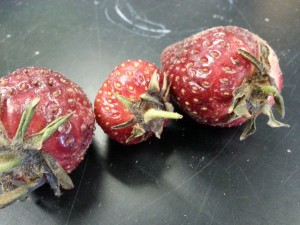Often considered a minor pathogen, angular leaf spot caused by the bacterium, Xanthomonas fragariae, can cause serious leaf and calyx infections ruining the marketability of fruit if left uncontrolled. Like all bacterium, the pathogen will infect leaves and the calyx through natural openings or wounds.

Fig. 1. Water-soaked lesions caused by angular leaf spot on infect strawberry leaf. Photo by P. Nitzsche

Fig. 2. Reddish-brown lesions on infected strawberry leaf caused by angular leaf spot. Note the translucent spots when held up to light. Photo by P. Nitzsche
Importantly, in severe outbreaks in the spring, the bacterium can spread to fruit causing the calyx to turn brown and dry out ruining the marketability of infected fruit (Figs. 3 & 4).

Fig. 3. Angular leaf spot infections on calyx of infected strawberry fruit. Photo by P. Nitzsche

Fig 4. Strawberry fruit infected with Angular leaf spot. Note the brown, dried up calyx.
The pathogen is easily spread via overhead irrigation and during rain and can be moved around the field during harvest. The bacterium may overwinter on infected plant debris buried in the soil for up to one year. Conventional or organic copper-based products can help suppress the development of ALS, and should be applied at a low rate to avoid phytotoxicity in leaves. Weekly, preventative applications of 0.3 lb fixed copper have been shown to be effective in reducing ALS if applied early enough when disease pressure was still low.

